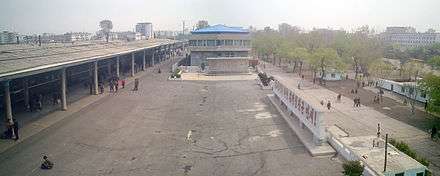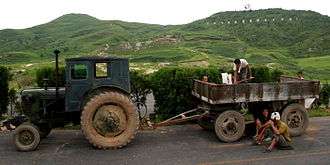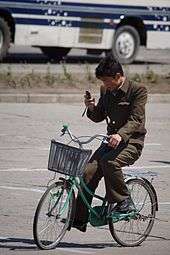Jangmadang

Jangmadang (Chosŏn'gŭl: 장마당), Korean for market grounds, is a term usually used to refer to North Korean farmers' markets, local markets and black markets. Since the North Korean famine, they have formed a large informal economy. In recent years, the government has become more lenient on their existence, but however, merchants still face heavy regulations. Currently a majority of North Koreans are dependent on markets for their survival.
The North Korean government has tried to regulate growth of the market economy in North Korea with a variety of methods. Some of them such as regulating age of traders has caused some societal changes such as making women more responsible for earning money for their families. This has resulted in changing gender roles in North Korean society.
There have been speculations on the possible role of black market in causing reforms of North Korean government and economy, possibly in similar manner as in China.
Background

After the collapse of the public distribution system in North Korea, the North Korean government allowed private markets. They originally sold essential items, rice and vegetables.[1] Private markets evolved from local communities involving various organizations, workplaces, relatives and neighbors, that helped people to survive during the famine. Many of these mutual-help arrangements broke up later on, as markets developed.[2]
Unlike in cities, the people use bartering instead of money to engage in trade.[1]
China dominates both official and unofficial economy in North Korea. Some people received their start-up capital from relatives in China. Many of these relatives also became partners and advisers in business.[3]
Overview
As a source of livelihood
.jpg)
As of 2008, an estimate of 70 percent of households living in cities engage in handicrafts, trade or transportation services related to trade. Without a working food distribution system, people need local markets to earn money and survive.[4] While actual monthly salary was two U.S. dollars, an average North Korean earned a total of around 15 dollars a month in 2011. Successful black-market operators and actual capitalistic success stories are rare, however, even if a few former laborers and farmers have become very rich with income of hundreds and even thousands of dollars a month.[3] Between a half and three-quarters of North Korean people's income come from various market activities. However, crackdowns by government lead to irregularities in business and bribing.[5]
Annual studies conducted among defectors by the Seoul National University Institute for Peace and Unification Studies revealed, even if the studies may be misrepresentative of the whole population, that little more than half of them received money from the North Korean state. A significant growth of number of the people engaged in private business activities and related bribing was also noted.[5]
Kookmin University professor Andrei Lankov reports that some Jangmadang merchants, in addition to the elite and foreign currency earners, have paid for private education of their children. Music, computers and foreign languages have been the most popular courses among the private courses. In North Korea, the songbun system heavily regulates access to public education, and people with a modest background have a difficult time to get into universities such as Kim Il-sung University. Andrei Lankov, however, welcomed a crackdown of the private education by North Korean officials, despite having doubts about corruption and competitiveness of the public education in North Korea.[6]
Food security
The traders smuggle food across the border from China to North Korea for sale.
Usually crops are the cheapest right after harvest season. In addition to the typical seasonal changes in the prices of crops, droughts in North Korea may cause severe increase in prices of foodstuffs, and harm people's ability to keep a balanced and nutritious diet. In 2015, the drought tripled the price of potatoes compared to same time in 2014. Rumors of a bad potato harvest coming also caused increase in prices.[7]
North Koreans who engage in various kinds of household business also farm private land. Those poorest North Koreans without an ability start even a food stall usually live through subsistence farming. Significant portion of North Korean food supply is produced illegally and privately, on small farm plots known in North Korea as sotoji (small land in Korean).[3]
Goods and services offered

Even if living conditions have not increased much in North Korea, the market activity and range of goods have had an increase. The quality of the goods has also increased.[1]
In 2008 among the most popular or wanted goods sold at markets were street food, car batteries, rice cookers, electric shavers, dress shoes, cosmetics, DVD-players, motorcycles and vinyl floor coverings. Many of the brand labels on goods for sale are fake, and pretend to be South Korean made goods.[4]
Cannabis may or may not be legal in North Korea. There is a report of it being sold in Rason market.[8][9] Other drugs like methamphetamine are undoubtedly illegal. North Korea has one of the worst drug problems in the world with much of the population addicted to the drugs, due to a widespread use of methamphetamine as a drug and medicine.
Livestock stalls are a recent addition with markets in large cities being transformed into agricultural markets.[10]
Money lending and foreign currency exchange have appeared with growth of the markets. As banks do not really function in North Korea, but in name, the market stalls are used as the main platform for banking transactions.[11] Many people use foreign currency for their savings and those selling more valuable goods often use Chinese Yuan. Taking a loan, to buy expensive goods such as a bicycles, has become more common.
Even private medical services have appeared in the markets with retired doctors offering their services, and with self-trained traditional Korean medicine practicers present too. The doctors charge around 10 dollars for a diagnosis, and some doctors fill in prescriptions for people. Many of these doctors had been unable to live on their measly wages. Black market medical services have been around since the free health care system collapsed in the 1990s. Some officials have themselves been forced to receive help from the same doctors they are supposed to crackdown.[12]
Role in possible reforms
One defector reportedly displayed surprise on the similarity between markets in North Korea and South Korea, instead of the contrasts.[1]
Some have talked about Jangmadang Generation while referring to the people born in the 1980s and 1990s.[13]
Kim Jong-un has been speculated to want more liberal marketplaces than Kim Jong-il.[10] However, as market trade has increased, support for Kim Jong-un among the people has not notably weakened, which casts into doubt the claim that market reforms would dwindle support for the regime.[5]
Access to outside information
Foreign media smuggled in North Korea may encourage people to defy their government, and encourage a regime change. Influence from relative Chinese prosperity may also make people want reforms.
Crackdowns and regulation by North Korean government
.jpg)
Some people sell their wares in alleyways near the actual marketplace to avoid harassment and extortion by officials of the Ministry of People's Security. These merchants are called, for their rapid proliferation, "tick merchants" in North Korea. They are also sometimes referred to as "grasshopper merchants".[14]
Around 2007, the officials tried to take control of sales of the Chinese-made plastic floor coverings, which had become popular and profitable with increasing living standards, by decreeing that they may be sold only through state-owned stores. The officials also tried to regulate private buses and trucks exceeding the weight limit of eight tons, and tried to register the violators as state employees and declare the vehicles as state property. This wholesale business with trucks is known as Chapan-Jangsa in North Korea. These two economic activities were among the three most profitable businesses in addition to methamphetamine sales.[15]
In 2013 an identity-based vendor system was started to stop people from avoiding stall rental fees. They now have to hold a vendor card around the neck during business hours. These vendor cards can be used to check if a merchant has paid the stall fees and to verify the identity. Vendors have also been made to rotate their stall locations.[11]
Some well-to-do merchants are allowed to skip the mobilizations by flexible local units. People with good songbun (family background) are also allowed more excuses for being absent.[7]
Age regulation
In 2008 women younger than 40 years old were banned from doing business in markets.[4]
However, under the rule of Kim Jong-un, the age limits have been removed from women, even though they have been raised for men. Currently only men over 60 are allowed to work on markets. This is an attempt to enforce loyalty of the workers to their workplaces, according to a Daily NK source from Ryanggang Province.[16]
Currency reforms
One theory of North Korean government's goals in the 2009 revaluation of the won, is that it targeted those traders who had grown very rich. The currency reform also caused an initial flurry of buying in jangmadangs by worried people to make sure their savings did not lose all of their value. For some time, only the Chinese Yuan, in addition to other foreign currencies, was practically accepted in trade, with the exception of food merchants selling rice. Eventually the new won stabilized near the pre-currency reform value, after suffering a period of hyperinflation.
Changing gender roles in North Korean society
.jpg)
During the North Korean famine, people received and shared help first in their local community through organizations, workplaces, relatives and neighbors. These networks for assistance and barter were based on existing solidarity and trust. It has been reported that even women's organizations, such as elderly women's association, were able to give help. The initial barter networks developed into early makeshift marketplaces. However, many of the originally existing mutual-help relations strained and broke up later on.[2]
Married women and elderly women with married children and grandchildren, played the most active role in the early mutual-help arrangements and the birth of marketplaces. North Korea human rights reporter Barbara Demick called these women "mothers of invention". These women were the ones to take risk of traveling great distances, and going to find food from countryside, or even from other provinces despite regulations against human mobility. The local administration in provinces which had suffered food shortages in the 1980s, was tolerant on the actions people took to survive. These women also defied regulations against unauthorized goods transactions, and some crossed the dangerous border to China as temporary migrants, to take the role of family's breadwinner.[17]
Historically in North Korea the man has been seen as a head of the family, and provider for family's livelihood, but with collapse of the North Korean economy, the men have been forced to stay in their workplaces even if they can not work in a non-functioning factory. As it has become impossible to live with monthly salary anymore, the role of the provider has increasingly fallen for women to do.[3] A married woman can be registered as a full-time housewife giving freedom to trade. Men have to pay to the factory management for the same unofficial privilege.[3] However, women's relative freedom has allowed some men to stay in market life to earn money. As men take care of the wholesale and transportation, the women take care of the actual selling of the goods on marketplaces.[16] According to Andrei Lankov, remarkably the women dominate North Korean economy on the lower levels. The women engage not only in trade, but on small scale household production making shoes, sewing garments and preparing food for sale.[3]
See also
- Economy of North Korea
- Informal economy of China
- North Korean studies
- Notel, a very popular Chinese media player in North Korea
- Poverty in North Korea
- Shibuya incident, a similar massive post-food shortage outburst of black markets occurred in Japan, but resulted in a societal chaos
- Telecommunications in North Korea
References
- 1 2 3 4 "North Korea's Jangmadang walls are growing higher". Retrieved 6 September 2015.
- 1 2 Kwon & Chung 2012, pp. 166–167.
- 1 2 3 4 5 6 Andrei Lankov. "NK is no Stalinist country". Retrieved 6 September 2015.
- 1 2 3 Park In Ho. "2008 Top Items in the Jangmadang". Daily NK. Retrieved 6 September 2015.
- 1 2 3 Benjamin Katzeff Silberstein (28 August 2015). "A new defector survey about market trade in North Korea, and what it says (maybe) about Kim Jong-un". www.nkeconwatch.com. Retrieved 6 September 2015.
- ↑ Andrei Lankov. "North Korean Crackdown on Private Education Overlooks Real Issue". Radio Free Asia. Retrieved 6 September 2015.
- 1 2 Unification Media Group. "Hot potato! Produce prices surge in drought". Daily NK. Retrieved 6 September 2015.
- ↑ Darmon Richter (September 2013). "On Smoking Weed in North Korea". www.thebohemianblog.com. Retrieved 6 September 2015.
- ↑ Darmon Richter (November 2013). "Smoking Weed in North Korea: A Critical Review". www.thebohemianblog.com. Retrieved 6 September 2015.
- 1 2 Unification Media Group (2015). "Livestock stalls introduced to 'jangmadang'". Daily NK. Retrieved 6 September 2015.
- 1 2 "North Korea Implements Identity-Based Vendor System". Retrieved 6 September 2015.
- ↑ Seol Song Ah (11 September 2015). "Black market diagnoses saving more lives". Daily NK. Retrieved 11 September 2015.
- ↑ Jihae Lee; George Swartz. "'Jangmadang Generation' at the core of change in NK". Daily NK. Retrieved 6 September 2015.
- ↑ Seol Song Ah. "Crackdowns Ease Up on Alley Merchants". Daily NK. Retrieved 6 September 2015.
- ↑ Yang Jung A (3 July 2007). "Purchase Popular Jangmadang Goods at State-Operated Stores.". Daily NK. Retrieved 6 September 2015.
- 1 2 Kang Mi Jin. "Men under 60 banned from market activities". Daily NK. Retrieved 6 September 2015.
- ↑ Kwon & Chung 2012, p. 168.
Sources
- Kwon, Heonik; Chung, Byung-Ho (12 March 2012). North Korea: Beyond Charismatic Politics. Rowman & Littlefield Publishers. pp. 166–168. ISBN 978-1-4422-1577-1.
- Kisan Gunjal; Swithun Goodbody; Siemon Hollema; Katrien Ghoos; Samir Wanmali; Krishna Krishnamurthy; Emily Turano (28 November 2013). "FAO/WFP Crop and Food Security Assessment Mission to the Democratic People's Republic of Korea" (PDF). FAO. Contributions by Belay Gaga, Bui Bong, Anna-Leena Räsänen, Xuerong Liu, Dawa Gyetse and Jennifer Rosenzweig. Retrieved 29 November 2015.
- Snyder, Scott (31 March 2010). "North Korea Currency Reform: What Happened and What Will Happen To Its Economy?" (PDF). The Asia Foundation. Retrieved 29 November 2015.
Further reading
- Smith, Hazel (2015). North Korea: Markets and Military Rule. Cambridge University Press. ISBN 978-1-316-23964-3.
External links
- North Korea Uncovered, a Google Earth plugin mapping many of the markets, at North Korean Economy Watch.
- Rice prices and USD exchange rate trends at major Jangmadangs of Hyesan, Pyongyang and Sinuiju at Daily NK
- Jangmadang generation-centric radio content imperative, say those who once tuned in at Daily NK
- Fringe market activities take a hit ahead of Party Foundation Day at Daily NK